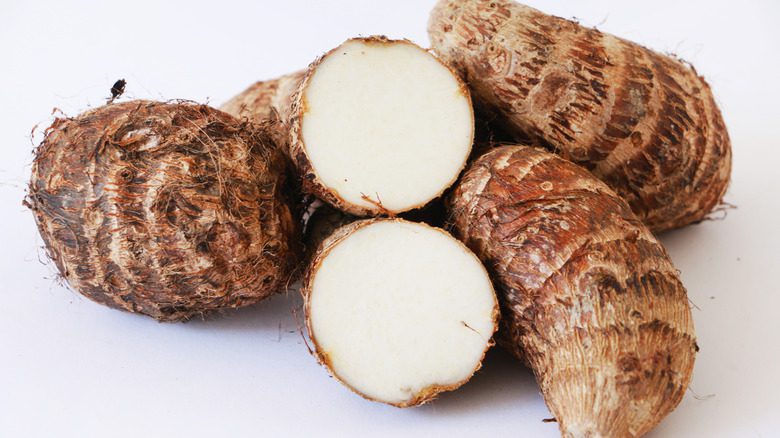Have you ever passed by a humble, hairy root at the market and wondered what secrets it holds? Taro root (Colocasia esculenta), an ancient staple from the lush tropics of Asia to the vibrant islands of Polynesia, is no ordinary tuber. This unassuming corm, with its nutty flavor and velvety texture, is a nutritional dynamo that’s been revered for millennia. From fueling warriors to gracing modern superfood menus, taro is staging a global comeback. Curious about how this ancient root can revolutionize your health and kitchen? Dive into its 15 science-backed benefits and discover simple, delicious ways to make taro your new wellness ally. Let’s unravel the magic of taro and keep you hooked on its incredible story.

🌟 Why Taro Is Your Next Wellness Obsession
Taro isn’t just a culinary delight—it’s a nutritional treasure chest. Known as arbi, dasheen, or cocoyam, this versatile root thrives in tropical climates, offering a mildly sweet flavor and a potato-like texture that’s perfect for everything from savory fries to creamy soups. Its heart-shaped leaves and starchy corm have been staples in dishes like Hawaiian poi, Indian curries, and Polynesian feasts for centuries. But taro’s real power lies in its nutrient density. Packed with fiber, resistant starch, antioxidants, and essential minerals, taro delivers benefits that touch every aspect of your health. From your gut to your heart, this ancient root is ready to transform your wellness routine. Ready to explore why taro is stealing the superfood spotlight?
🥗 The Nutritional Powerhouse Within Taro
What makes taro stand out in a world of root vegetables? A single cup (about 132 grams) of cooked taro is loaded with:
- Fiber: 6.7 grams to keep your digestion humming.
- Resistant Starch: Fuels gut-friendly bacteria and stabilizes blood sugar.
- Vitamins: C, E, and B6 for immunity, skin health, and energy.
- Minerals: Manganese, potassium, and magnesium for bones, heart, and muscles.
- Antioxidants: Quercetin and anthocyanins to fight oxidative stress.
Unlike potatoes, taro boasts a lower glycemic index, making it a smart choice for blood sugar control. Its affordability, versatility, and sustainability make it a must-have for health-conscious foodies. But here’s the catch: taro must be cooked thoroughly to neutralize calcium oxalate, a natural compound that can irritate if consumed raw. With proper preparation, taro unlocks a world of wellness benefits that are hard to ignore.
🛡️ 15 Science-Backed Benefits of Taro Root
Taro’s impressive nutrient profile translates into real, tangible health benefits. Here’s why this root deserves a spot in your diet:
- Boosts Digestive Health
Fiber and resistant starch act as prebiotics, feeding beneficial gut bacteria. This duo reduces bloating, improves bowel regularity, and supports a balanced microbiome, keeping your gut happy and healthy. - Stabilizes Blood Sugar
Resistant starch slows glucose absorption, preventing spikes and crashes. Taro’s low glycemic index makes it a smart choice for managing diabetes or maintaining steady energy levels. - Promotes Heart Health
Potassium helps regulate blood pressure, while fiber lowers LDL (bad) cholesterol. Together, they reduce the risk of heart disease, keeping your ticker in top shape. - Fights Oxidative Stress
Antioxidants like quercetin and anthocyanins neutralize free radicals, protecting your cells from damage linked to aging and chronic diseases. - Aids Weight Management
High fiber and resistant starch keep you full longer, curbing cravings and reducing overall calorie intake. Taro is a satisfying, low-calorie addition to any diet. - Supports Eye Health
Beta-carotene and cryptoxanthin, precursors to vitamin A, protect against age-related macular degeneration and maintain sharp vision. - Strengthens Bones
Calcium and magnesium work together to support bone density, reducing the risk of osteoporosis and keeping your skeleton strong. - Acts as a Natural Diuretic
Potassium helps flush excess fluids, supporting kidney function and reducing water retention for a lighter, healthier you. - Enhances Brain Function
Vitamin B6 and manganese support neurotransmitter production and energy metabolism, boosting focus and cognitive health. - Bolsters Immunity
Vitamin C and antioxidants strengthen your body’s natural defenses, helping you fend off colds and infections. - Promotes Radiant Skin
Vitamins E and A shield skin from UV damage, promote collagen production, and keep your complexion glowing. - Supports Muscle Recovery
Magnesium reduces muscle cramps, while amino acids aid tissue repair, making taro a great post-workout ingredient. - May Reduce Cancer Risk
Early lab studies suggest quercetin may inhibit the growth of certain cancer cells, offering potential protective effects. - Relieves Inflammation
Polyphenols and omega-3 fatty acids reduce joint pain and inflammation, easing discomfort from arthritis or injury. - Supports Sustainable Living
Taro thrives in poor soils, making it an eco-friendly crop that enriches ecosystems and supports sustainable gardening.

🍴 5 Delicious Ways to Bring Taro into Your Kitchen
Ready to make taro a star in your meals? Here are five simple, mouthwatering recipes to get you started. Always cook taro thoroughly to ensure safety and maximize flavor.
- Crispy Taro Fries
Slice taro into thin strips, toss with olive oil, paprika, and a pinch of sea salt. Bake at 400°F (200°C) for 20–25 minutes, flipping halfway. Enjoy a crunchy, guilt-free snack that’s perfect for dipping. - Creamy Taro Soup
Dice taro and simmer with onions, ginger, and vegetable broth. Blend with coconut milk for a velvety, gut-soothing soup that warms the soul. - Taro Pancakes
Mash boiled taro and mix with flour, egg, milk, and a dash of cinnamon. Cook 2–3 minutes per side for fluffy, nutrient-packed pancakes that elevate your breakfast game. - Taro Leaf Tea
Boil 2–3 cooked taro leaves for 15 minutes, strain, and sweeten with honey. This soothing tea supports respiratory health and calms the body. - Taro Poultice for Joint Relief
Mash cooked taro with a pinch of turmeric and apply to sore joints for 20–30 minutes. This natural remedy reduces inflammation and eases discomfort.
⚠️ Safety First: How to Handle Taro
Taro is a nutritional gem, but it requires careful preparation. Follow these tips to enjoy it safely:
- Cook Thoroughly: Raw taro contains calcium oxalate, which can irritate the throat or stomach. Boil, bake, or steam until soft.
- Wear Gloves: Peeling raw taro may irritate sensitive skin. Use gloves to stay comfortable.
- Test for Allergies: Try a small portion first to ensure you don’t have a rare sensitivity.
- Mind Kidney Health: If prone to kidney stones, consult a doctor, as taro contains oxalates.
- Moderation is Key: Stick to ½–1 cup per serving to balance your diet.
- Pregnancy and Breastfeeding: Culinary amounts are safe, but consult a doctor for medicinal uses.
- Foraging Caution: Ensure proper identification to avoid toxic look-alikes like elephant foot yam.
🌍 Why Taro Outshines Other Roots
Taro isn’t just another starchy staple—it’s a nutritional and cultural icon. Compared to potatoes, taro offers more fiber, a lower glycemic index, and a richer array of vitamins and minerals. Its versatility shines in both savory and sweet dishes, from fries to desserts. Plus, taro’s ability to thrive in poor soils makes it a sustainable choice for eco-conscious eaters. Whether you’re blending it into smoothies, roasting it for snacks, or using its leaves for tea, taro delivers unmatched flavor and benefits.

💫 Taro’s Timeless Appeal
Taro root is more than a food—it’s a bridge to ancient traditions and modern wellness. Its 15 science-backed benefits, from gut health to inflammation relief, make it a must-have for anyone seeking a healthier, more vibrant life. With its nutty flavor, creamy texture, and eco-friendly roots, taro is ready to transform your kitchen and your health. Start with a simple recipe like taro fries or soup, and let this ancient root work its magic. Your body, taste buds, and planet will thank you for embracing the power of taro.
Ready to unearth the magic of taro? Grab a root, cook it up, and discover why this ancient superfood is capturing hearts and plates worldwide.









